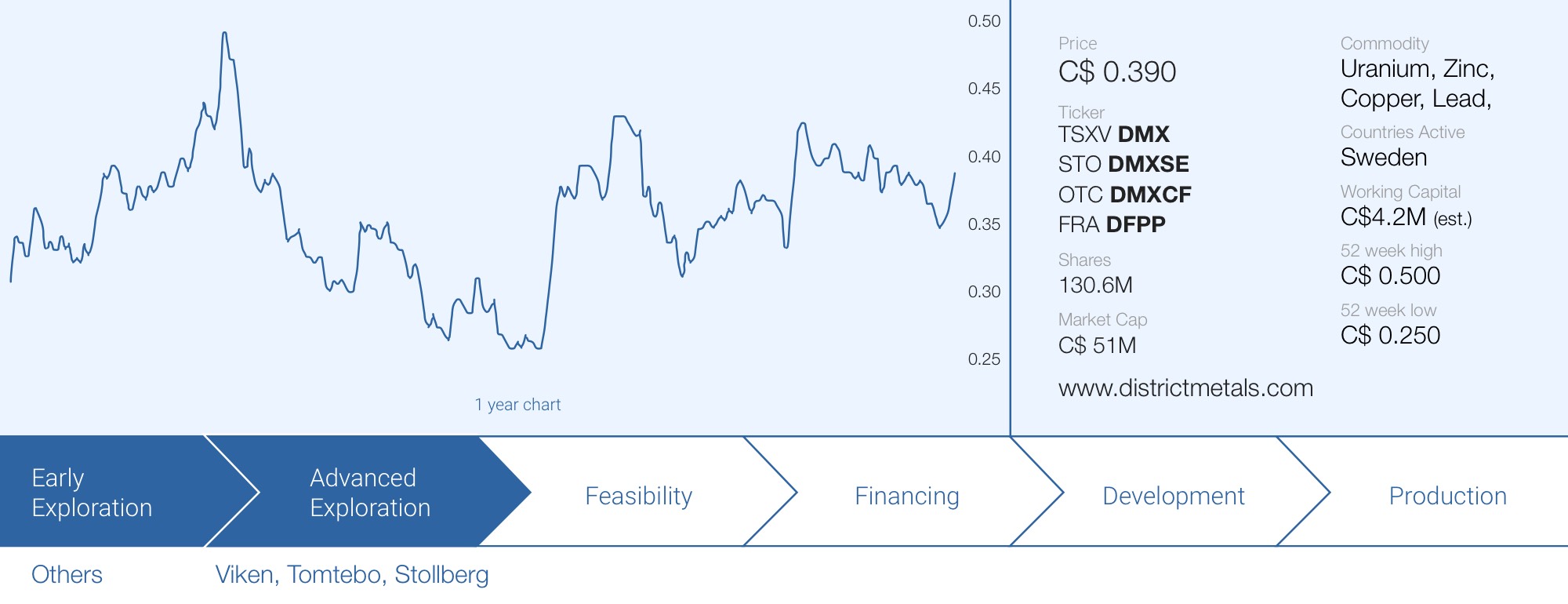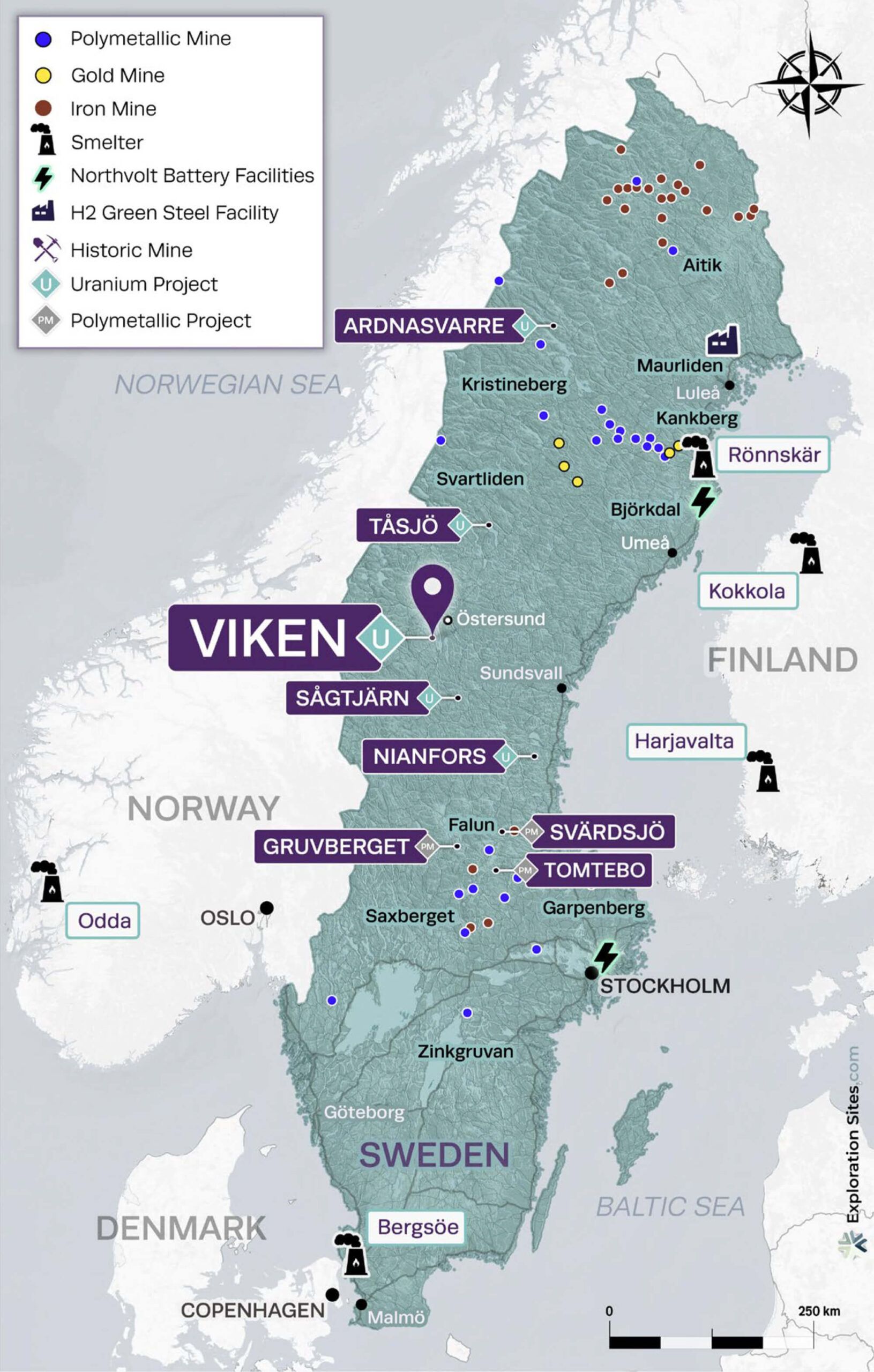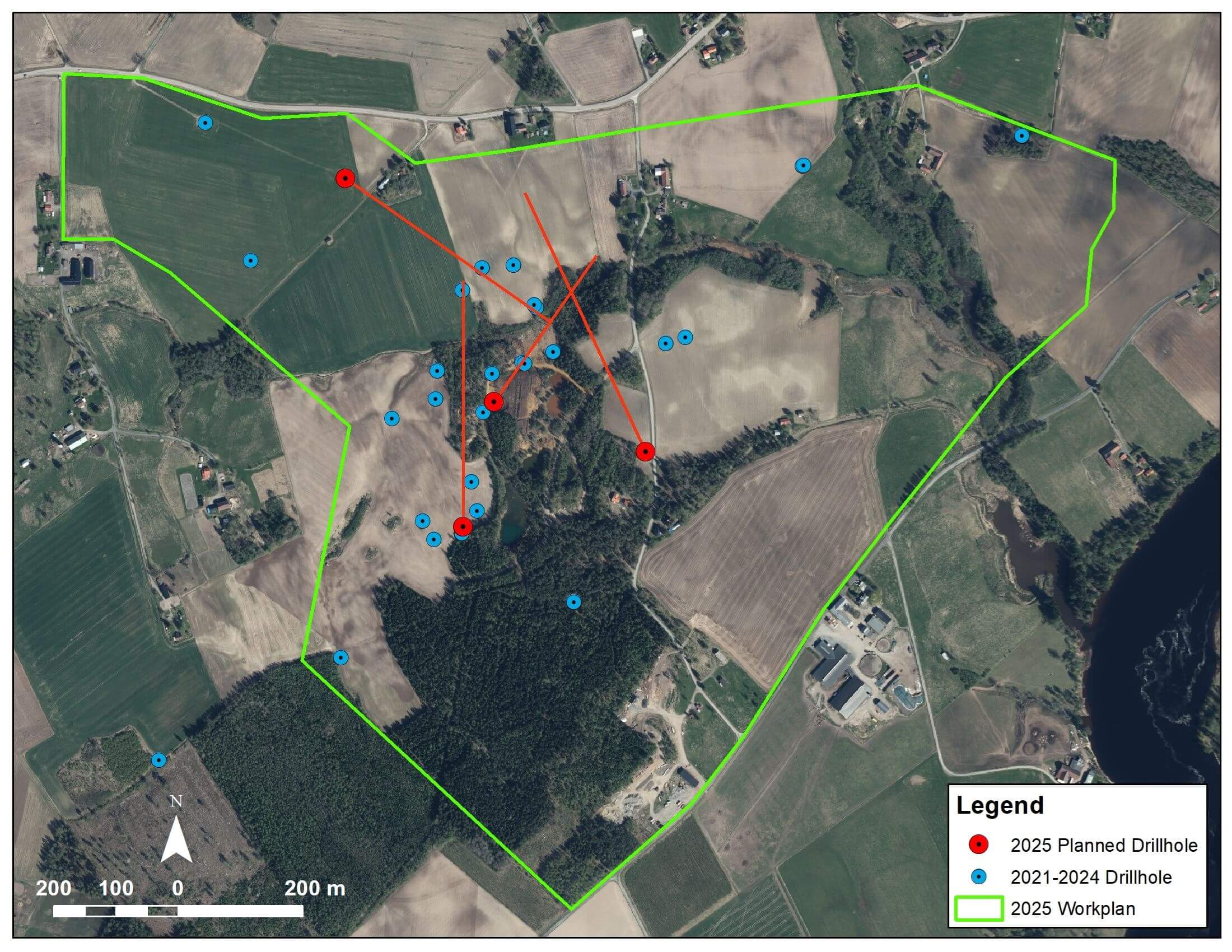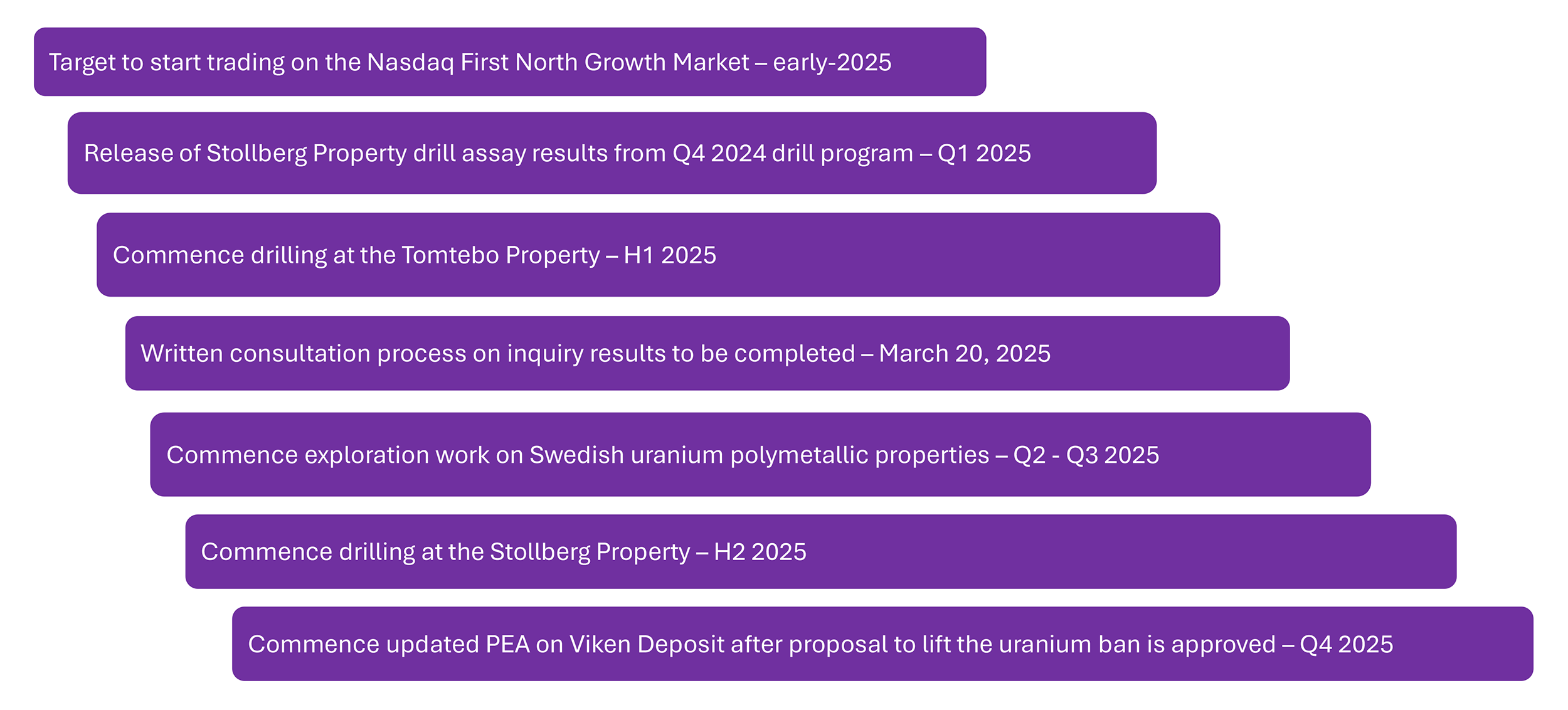
One would almost forget District Metals (DMX.V) could become one of the largest suppliers of uranium to European end-users. As the company only has a historical resource estimate that was compiled in 2014, it is now planning to bring the historical resource current, using the NI 43-101 standards. It will be interesting to see if and how the current resource with in excess of 1.1 billion pounds of U3O8 in the inferred resource category can be brought current. A NI 43-101 compliant resource calculation should carry more weight than a historical resource calculation.
District Metals is now also trading on the Nasdaq First North Growth Market in Stockholm after a successful application to list the Swedish depository receipts on the market. Hopefully this will attract some local investors that did not want to trade in Canada or didn’t have access to Canadian stocks before. It makes sense for a company with virtually all of its significant projects (other than Bakar in British Columbia) in Sweden to obtain a Swedish listing. Interestingly, the stock is trading at a premium in Sweden. The current share price of 2.92 SEK represents C$0.39/share, while the shares in Canada are trading at just C$0.355 in Canada at the closing bell on Thursday.

District Metals is doing all the right things: it’s adding value to its Viken ownership by repurchasing the 2% NSR on certain portions of the asset, it is advancing Viken towards an updated resource estimate which will pave the way for an economic study, and it obtained a local listing in the country where the project is located. A slightly improving uranium and/or vanadium market and getting definitive clarity on lifting the uranium moratorium would be helpful to generate renewed interest in this story.
Advancing Viken
Earlier this month, District Metals announced it retained P&E Mining Consultants to prepare a NI 43-101 compliant mineral resource estimate on the flagship Viken project. P&E also completed the two historical resource estimates that were published in 2010 and 2014. The 2014 resource calculation contained in excess of 3 billion tonnes of rock with an average grade of 170 ppm U3O8, 0.034% Nickel, 0.012% copper and 0.042% zinc for a total metal content of 1.15 billion pounds of uranium, 2.2 billion pounds of nickel, almost 800 million pounds of copper and 2.8 billion pounds of zinc. The indicated resource was much smaller but added 18 million pounds of uranium and 32 million pounds of nickel to the global resource.

Keep in mind this is a historical resource estimate and is not a current as per the NI 43-101 standards, which is why District Metals would like to upgrade the historical resource to a compliant resource.
It’s perhaps also worth emphasizing the 2010 and 2014 historical resource calculations confirmed the presence of a multi billion tonne resource; and as you saw above, the 2014 historical resource includes in excess of 3 billion tonnes in the inferred resource category.
But bigger isn’t always better. Aura Energy’s nearby Haggan deposit likely has found the ‘sweet spot’ when it comes to finding the optimal processing rate. Based on the Haggan Scoping Study, a throughput of 9,500 tonnes per day appears reasonable. At that throughput, a 3 billion tonne resource would underpin a mine life of 90 years.
Simply put: District Metals does not need the three billion tonnes to make the project work and we would not consider it to be a negative element if not all 3 billion tonnes would add up in the updated resource. Two other elements in the updated resource will be important though: defining the high-priority zones for infill drilling to bring a substantial portion of the inferred resources into the indicated resource category while the updated technical report should also incorporate updated metallurgical data for alum shales.
Once the resource will have been brought up to date, District Metals can start to consider working on an updated Preliminary Economic Assessment for Viken.







The Viken royalty repurchase
District Metals continues to enhance the value of the project ahead of the (anticipated) decision of the Swedish government to lift the uranium moratorium in September 2025.
As you may remember, when District Metals consolidated the entire Viken land package, it had to issue a 2% NSR on some of the claims as part of the consideration. The company has now repurchased the 2% NSR in return for 500,000 shares of District Metals (with a pro forma value of approximately C$200,000). This is a very smart way for District Metals to bring the project to a royalty-free status, while the seller of the NSR expects to make a profit on the shares as the official lifting of the uranium moratorium in Sweden should make District Metals more valuable.
In any case, repurchasing the 2% NSR is a good value proposition and it clearly increases the value of the project.
Boliden approved the exploration plans for the Tomtebo and Stollberg base metal projects
Earlier this month, District Metals announced the District and Boliden teams have come to an agreement to spend C$3M on exploration on the Tomtebo and Stollberg base metal properties in Sweden (to be abundantly clear, Boliden is not involved in District Metals’ uranium plans and projects). The C$3M exploration budget for this year represents a 50% increase from last year’s budget, and the joint venture partners aim to spend equal amounts on both the Tomtebo as well as the Stollberg properties.
At Tomtebo, the current plan is to complete three or four holes for a total of 1,500-2,000 meters, indicating the partners will drill deep holes. The holes are designed to drill-test the broader Steffenburgs Zone and will step out below TOM24-042 which encountered in excess of 29 meters of 0.95% copper, 2.4% ZnPb, 0.67 g/t gold and 30 g/t silver.

Those deeper holes will subsequently be following up on using Boliden’s proprietary down-hole electromagnetic survey.
District and Boliden won’t just drill the two known mineralized zones at Tomtebo. The companies are also completing the permitting process to drill-test the historical Lovas Mine and the Kvistaberget target.
The idea to drill-test the latter is underpinned by a SkyTEM conductive anomaly and a trend of historical copper sulphide workings that appear to be located along strike from the VMS horizon that was encountered at the old Tomtebo mine.
The Lovas Mine is a past-producing mine but as the mine only reached a depth of less than 200 meters, there may be plenty of interesting rock left in the ground. Additionally, historical drill holes appear to indicate that the polymetallic mineralization remains open at depth and along strike. Needless too say this too is an interesting exploration target and we are looking forward to seeing the plans once the project has been permitted.

Conclusion
We like District Metals’ methodological approach. Although the pace to advance the Viken energy metals project will be determined by the progress made by the Swedish government to lift the uranium moratorium. But while District Metals doesn’t control that timeline, it is ticking the boxes related to the elements it can control. The 2% NSR on certain claims was repurchased and there is a short-term plan to update the 2014 resource and publish a current NI 43-101 compliant mineral resource estimate. District Metals will be ready to hit the ground running in Sweden if/when the uranium moratorium gets lifted in September 2025.
Meanwhile, the short-term news flow will likely be related to the base metals drill and exploration programs. While this could return interesting results and additional data to improve the understanding of the polymetallic projects, the company’s investor base is likely mainly focusing on the uranium aspect.
Disclosure: The author has a long position in District Metals. District Metals is a sponsor of the website. Please read our disclaimer.